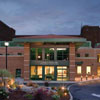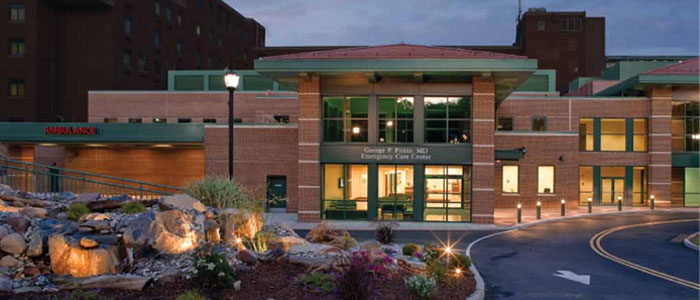
Into The Future
Endless possibilities take New Jersey hospital forward
- By Kim Rahfaldt
- Apr 01, 2012
Since 1925, northern New Jersey has turned to Holy Name Medical Center in Teaneck for healthcare excellence. Distinguished by its long history of innovation and remarkable record of achievements and firsts, Holy Name has evolved into a comprehensive medical center providing high-quality healthcare across a continuum that encompasses education, prevention, early intervention, treatment, rehabilitation and wellness maintenance. In 2009, there were more than 20,000 inpatient admissions, 53,000 visits to the emergency care center, 13,000 visits to the medical center’s clinics and almost 11,000 surgeries performed at the organization’s main location.

But while its growth in patient volume and service delivery have undergone extensive expansion, Holy Name Medical Center (HNMC) employed an outdated and difficult-to-maintain security system that had outlived its usefulness. Its newly built emergency care center and status as a medical coordination center for disaster preparedness helped drive the funding needed to invest in a new security management system. Stakeholders chose AMAG Technology’s Symmetry security management system (SMS) with Symmetry video, offering access control, video and alarm monitoring on one platform.
One Card Solution
An important requirement of SMS was its ability to integrate with current systems already in place at HNMC. Symmetry integrates with the existing time and attendance system, and employees now use the same badge for access control and time and attendance. Symmetry also integrates with HNMC’s Human Resources PeopleSoft software. The Symmetry/PeopleSoft integration simplified the employee registration process because personnel data is entered only once into the PeopleSoft system.
“When they register an employee in PeopleSoft, that person is enrolled in the time and attendance software and Symmetry system,” said David George, the installing integrator at Engineered Security Systems Inc. “They print the badge, and they are done. That was a key feature they wanted in the system.”
Planning for the Future, Now
In addition to the main campus location, an administrative building, a fitness center located nearby, and the soon-to-open Villa Marie Claire hospice are all protected by the Symmetry SMS. ESS and HNMC’s IT department studied how the camera resolution would stream via the network and learned how much bandwidth was truly necessary to produce the video quality HNMC required. ESS recommended using an existing fiber network that was not currently being used. The separate network provides plenty of room for the rapid growth anticipated by HNMC.
“One of the biggest problems we see is that companies don’t perform the proper calculations and place anything on their existing network,” said Ken Whelan, an engineered security systems engineer. “Since the original design, Holy Name has almost doubled the number of cards and cameras. That would have overloaded the system and been a disaster if the system wasn’t on a separate network.”
ESS originally designed a futureproof SMS so as more components were added to the system, they would not slow down the network. For example, a recently added video server didn’t affect the system at all. ESS also encouraged HNMC to purchase more camera licenses than the original system design recommended.
“We provided Holy Name with tiered expandability so they could expand quickly with licenses and hardware and not get hit with more license and server upgrade costs right away,” George said. “They purchased enough software licenses to expand 50 percent and server hardware to support a 100 percent expansion. We prepared them for the future right away.”
Everyday Security
Approximately 160 cameras monitor main doors, corridors, elevators, intersections, the behavioral health unit and the facilities management area. PTZ cameras scan the ER and parking lots.
“If we have an incident, we pull up the camera in the virtual matrix and review the video,” said Jerry Conway, HNMC security manager. “We may not be viewing cameras every minute of the day, but we can always look back and track someone. The more cameras we install, the easier it is to do that.”
Almost 40 security officers rotate shifts and man the new command center 24 hours a day. The security command center is located adjacent to the new emergency department and contains four 42-inch LCD screens on the wall. Camera images stream to three screens, and alarms are displayed on the fourth screen. Two workstations with 20-inch screens monitor control points and assist with badge production. One workstation creates badges for employees, contractors and temporary workers.
The command center is located next to the outside exit. Patients must pass through the command center to enter the ED. The command center uses a special glass that can fog up the window for additional privacy, and security officers have the option of generating a clear or obscured view.
Security officers also can pull up the system at remote stations located throughout the medical center to view activity. The remote stations allow the officers to view activity instantaneously and respond quickly to alarms. The officers appreciate the user-friendliness of the system when performing functions such as opening doors remotely and playing back video.
Human resources staff and the head of security enter Symmetry using a Web browser interface, but what Conway really likes is the flexibility and communication the Web-based access rights provide from a remote location.
“We like the flexibility of the Web-based access,” Conway said. “Our intent is to share SMS with our emergency service partners. Whether they are local, or from the county or state, they can access Symmetry through the Web.”
HNMC uses the system to control what areas of the medical center are active at specific times of the day. While some locations remain open via access control, the Human Resources Department, in-house child care wing and School of Nursing are locked down after 5 p.m., for added security.
Unique Benefits
HNMC is the medical coordination center for Bergen County. The MCC network is part of the New Jersey Department of Health and Senior Services Health Infrastructure Preparedness and Emergency Response Division. Holy Name is one of nine hospitals in New Jersey that participate in the MCC program. As an MCC, HNMC shares information about hospitals, nursing homes, assisted living facilities, health departments and EMS agencies with other local hospitals and the state. Mutualink, a Web-based interoperability system, allows HNMC to share radio channels and video systems with the eight other MCC hospitals. Mutualink is interfaced with SMS. In the event of a large-scale emergency, video of HNMC’s emergency department or lobby can be sent electronically to the state for review and analysis over the Mutualink network. Symmetry provides a catalyst for the education of other hospitals.
“As an MCC, Holy Name can provide information about the health side of a disaster,” Gerity said. “Symmetry is another source to provide information through the MCC to the state.”
HNMC was planning to purchase a separate guard tour system for its security officers. With 160 camera views streaming into the virtual matrix, the security officers could “see” everything necessary to perform their jobs effectively. Symmetry provided the camera control needed, and the officers controlled what the cameras viewed.
The Quick View feature has provided HNMC’s security officers with information to determine the cause of alarms. A tab on the monitoring screen allows an officer to take a retroactive look at what caused an alarm.
The Future is Here
Once HNMC fully understood the system’s capabilities, planning for the future began immediately. At this time, the medical center plans to interface Symmetry with its visitor parking lot’s cashiering system. Symmetry will control who enters and leaves the parking lot. Contractors and temporary people will be given cards with an expiration date. They will be allowed to park in the visitor lot until their card expires. The cards also will count the number of cars in the lot and help manage traffic flow. The system will eliminate parking abuse and allow pre-approved individuals access to the visitor lot.
The Threat Level Manager (TLM) module has been installed and soon will be integrated with HNMC’s infant protection system via alarm points. In the event of an emergency, Symmetry TLM will instantly lock down the LDRP unit so only security officers can move around the floor.
“Threat Level Manager allows us great flexibility,” Gerity said. “We plan to use as many features of the system as we can. The robustness of the system is one of the reasons we chose it.”
The medical center has already started to reassess its facility, as well as the security system’s capabilities. HNMC received federal funding and is reapplying for a grant to fine-tune high priority areas such as the ventilation system, facilities management areas and critical infrastructure within the complex.
This article originally appeared in the April 2012 issue of Security Today.